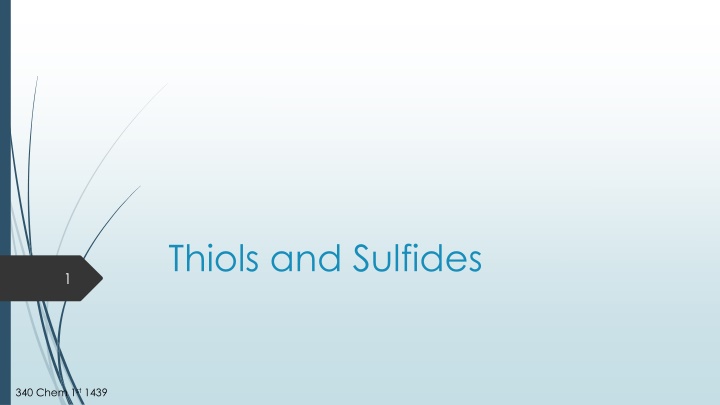Introduction to Thiols and Sulfides
Thiols and sulfides are important organic compounds with unique properties and nomenclature. Thiols, with the functional group SH, are sulfur analogues of alcohols, while sulfides are thioethers. Learn about their structures, naming conventions, physical properties, and reactions.
Download Presentation

Please find below an Image/Link to download the presentation.
The content on the website is provided AS IS for your information and personal use only. It may not be sold, licensed, or shared on other websites without obtaining consent from the author.If you encounter any issues during the download, it is possible that the publisher has removed the file from their server.
You are allowed to download the files provided on this website for personal or commercial use, subject to the condition that they are used lawfully. All files are the property of their respective owners.
The content on the website is provided AS IS for your information and personal use only. It may not be sold, licensed, or shared on other websites without obtaining consent from the author.
E N D
Presentation Transcript
Thiols and Sulfides 1 340 Chem 1st 1439
2 General formula of Thiols & Sulfides Nomenclature of Thiols & Sulfides Physical Properties of Thiols & Sulfides Preparations of Thiols & Sulfides Reactions of Thiols & Sulfides 340 Chem 1st 1439
Thiols 3 Thiols, general formula RSH, are the sulphur analogues of alcohols. The functional group of a thiol is SH. The simplest members of this class are methanethiol (CH3SH), ethanethiol (C2H5SH) and propanethiol (C3H7SH). The functional group of a thiol is an -SH (sulfhydryl) group bonded to an sp3 hybridized carbon
Nomenclature of thiols 4 In the IUPAC system, thiols are named by selecting as the parent alkane the longest chain of carbon atoms that contains the -SH group. To show that the compound is a thiol, retain the final -e in the name of the parent alkane and add the suffix -thiol. The location of the -SH group takes precedence over alkyl groups and halogens in numbering the parent chain. In the IUPAC system, -OH takes precedence over -SH in both numbering and naming. In compounds containing these two functional groups, an -SH group is indicated by the IUPAC prefix sulfanyl-. Alternatively, it may be indicated by the common- name prefix mercapto-. Common names for simple thiols are derived by naming the alkyl group bonded to !SH and adding the word mercaptan.
SH SH SH HO IUPAC name 5 2-Sulfanylethanol ( -Mercaptoethanol) 1-Butanethiol (Butyl mercaptan) 2-Methyl-1-propanethiol (Isobutyl mercaptan) common name SH HS 2-Butene-1-thiol 3-Methyl-1-butanethiol (Isopentyl mercaptan)
Sulfides nomenclature 6 The sulfur analogues of ethers are called sulfides or thioethers . Sulfur is an excellent nucleophile because its electron cloud is polarizable Thioethers are named in much the same way as their oxygen cousins, ethers. "Simple" thioethers If both groups are simple alkyl groups, then the thioether is usually named as alkyl alkyl thioether The alkyl groups are listed in alphabetical order If the two alkyl groups are the same, then it's a dialkyl thioether S S S M e t h y l s u l f a n y l m D M e t h a n e 3 - M e t h y l s u l f a n y l - c y c l o h e x e n e M e t h y l s u l f a n y l - b e n z e n e e t h y l P e t h y l t h i o b e n z e n e IUPAC name i m e t h y l t h i o m e t h y l s u l f i d e M h e n y l s u l f i d e common name M e t h a n e 3 - ( M e t h y l t h i o l ) c y c l o h e x e n e IUPAC name
Physical properties of thiols 7 The SH bond in thiols is less polar than OH bond in alcohols, since sulphur is less electronegative than the oxygen atom. Thus, thiols form much weaker hydrogen bonding than alcohols, and have lower boiling points than analogous alcohols
Acidity and basicity of thiols 8 Thiols are stronger acids (p K a 10) than alcohols (p K a 15). The greater acidity of thiols compared to alcohols can be explained by the fact that sulfur (a third-period element) is larger than oxygen (a second- period element). The negative charge on an alkylsulfide ion (RS-) is delocalized (spread) over a larger area and is therefore more stable than the negative charge on an alkoxide ion (RO-). C H 3C H 2S N a + + N a O H H 2O C H 3C H 2S H p K a = 1 0 . 5 p K a = 1 5 . 7 ( S t r o n g e r a c i d ) ( S t r o n g e r b a s e ) ( W e a k e r b a s e ) ( W e a k e r a c i d ) Thiolate ions (e.g. CH3CH2S-) are stronger nucleophiles and weaker bases than corresponding alkoxides (CH3CH2O-). Conversely, thiols are stronger acids than corresponding alcohols.
Preparation of thiols Thiols are prepared from alkyl halides and sodium hydrosulphide (Na+SH-) {excess of KOH (NaOH) and hydrogen sulfide H2S} by SN2 reaction. A large excess of Na + SH- is used with unhindered alkyl halide to prevent dialkylation (R-S-R). R-X Na+-SH R-SH Alkyl halide Thiol 10 Thiols can also be formed by reducing disulfides with zinc in the presence of acid R-S_S_R Zn/ H+ RSH
For a pure alkylthiol : 11 The thiourea (NH2(C=S)NH2) acts as the nucleophile in an SN2 reaction to produce an S-alkylisothiouronium salt which is then hydrolyzed with aqueous base to give the thiol.
Preparation of sulfide 12 substitution of alkyl halides with thiolates to form thioethers (sulfides). This process resembles the Williamson ether synthesis. First, a strong base deprotonates the thiol (we use NaH here, but many other bases could also be used). Secondly, we add an alkyl halide (1o ,2o), and an SN2 nucleophilic substitution reaction results in formation of S-C and breakage of C-Br with inversion of stereochemistry.
13 Symmetrical sulfides, RSR (also called symmetrical thioethers), are prepared by treating one mole of Na2S (where S2 is the nucleophile) with two moles of haloalkane. 2 R X N a 2 S + R S R2 + N a X This same reaction can also be used to prepare five- and six-membered cyclic sulfides. Treating a 1,4-dihaloalkane with Na2S gives a five- membered cyclic sulfide; treating a 1,5-dihaloalkane with Na2S gives a six-membered ring. 2 N a C l N a2S + + C l C l S T h io la n e (T e tra h y d ro th io p h e n e ) 1 ,4 -D ic h lo ro b u ta n e 2 N a C l N a2S + + S C l C l 1 ,5 -D ic h lo ro p e n ta n e T h ia n e (T e tra h y d ro th io p y ra n )
14 the intramolecular version is important to note. Note that we re still forming C S here and breaking a carbon-halide bond. Don t forget that inversion occurs on the stereocenter on the secondary carbon!
Reactions of thiols Oxidation 15 Thiols can be easily oxidized to disulfides through treatment with a mild oxidant like bromine or iodine (I2). Vigorous oxidation with KMnO4, HNO3 or sodium hypochlorite (NaOCl) produces sulphonic acids not give = bond . Note:Thiols react with base to form thiolate ions which can act as powerful nucleophiles A second oxidation pathway involves oxidation of sulfides to sulfoxides and sulfones through treatment with oxidants such as O3(ozone) and peroxyacids such as m-chloroperoxybenzoic acid (mCPBA), sodium periodate, NaIO4. Note that sulfur can exceed an octet of electrons whereas oxygen cannot.
16 Dimethyl sulfoxide (DMSO) is manufactured on an industrial scale by air oxidation of dimethyl sulfide in the presence of oxides of nitrogen.





